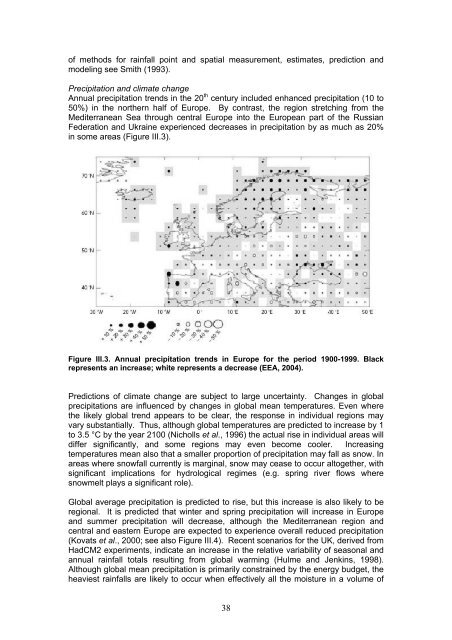Climate Change and the European Water Dimension - Agri ...
Climate Change and the European Water Dimension - Agri ...
Climate Change and the European Water Dimension - Agri ...
You also want an ePaper? Increase the reach of your titles
YUMPU automatically turns print PDFs into web optimized ePapers that Google loves.
of methods for rainfall point <strong>and</strong> spatial measurement, estimates, prediction <strong>and</strong><br />
modeling see Smith (1993).<br />
Precipitation <strong>and</strong> climate change<br />
Annual precipitation trends in <strong>the</strong> 20 th century included enhanced precipitation (10 to<br />
50%) in <strong>the</strong> nor<strong>the</strong>rn half of Europe. By contrast, <strong>the</strong> region stretching from <strong>the</strong><br />
Mediterranean Sea through central Europe into <strong>the</strong> <strong>European</strong> part of <strong>the</strong> Russian<br />
Federation <strong>and</strong> Ukraine experienced decreases in precipitation by as much as 20%<br />
in some areas (Figure III.3).<br />
Figure III.3. Annual precipitation trends in Europe for <strong>the</strong> period 1900-1999. Black<br />
represents an increase; white represents a decrease (EEA, 2004).<br />
Predictions of climate change are subject to large uncertainty. <strong>Change</strong>s in global<br />
precipitations are influenced by changes in global mean temperatures. Even where<br />
<strong>the</strong> likely global trend appears to be clear, <strong>the</strong> response in individual regions may<br />
vary substantially. Thus, although global temperatures are predicted to increase by 1<br />
to 3.5 °C by <strong>the</strong> year 2100 (Nicholls et al., 1996) <strong>the</strong> actual rise in individual areas will<br />
differ significantly, <strong>and</strong> some regions may even become cooler. Increasing<br />
temperatures mean also that a smaller proportion of precipitation may fall as snow. In<br />
areas where snowfall currently is marginal, snow may cease to occur altoge<strong>the</strong>r, with<br />
significant implications for hydrological regimes (e.g. spring river flows where<br />
snowmelt plays a significant role).<br />
Global average precipitation is predicted to rise, but this increase is also likely to be<br />
regional. It is predicted that winter <strong>and</strong> spring precipitation will increase in Europe<br />
<strong>and</strong> summer precipitation will decrease, although <strong>the</strong> Mediterranean region <strong>and</strong><br />
central <strong>and</strong> eastern Europe are expected to experience overall reduced precipitation<br />
(Kovats et al., 2000; see also Figure III.4). Recent scenarios for <strong>the</strong> UK, derived from<br />
HadCM2 experiments, indicate an increase in <strong>the</strong> relative variability of seasonal <strong>and</strong><br />
annual rainfall totals resulting from global warming (Hulme <strong>and</strong> Jenkins, 1998).<br />
Although global mean precipitation is primarily constrained by <strong>the</strong> energy budget, <strong>the</strong><br />
heaviest rainfalls are likely to occur when effectively all <strong>the</strong> moisture in a volume of<br />
38













